
Macaria brunneata, the Rannoch looper, is a moth of the family Geometridae. The species was first described by Carl Peter Thunberg in 1784. It is found in Siberia, Japan, and northern and mountainous parts of North America, and throughout Europe, though in Britain it is largely or entirely restricted to mature forests in central Scotland.

Bastilla is a genus of moths in the family Erebidae. The genus was described by Charles Swinhoe in 1918.

Zale is a genus of moths in the family Erebidae erected by Jacob Hübner in 1818.

Elusa is a genus of moths of the family Noctuidae erected by Francis Walker in 1859.

Syngrapha abstrusa, the abstruse false looper, is a moth of the family Noctuidae. The species was first described by Thomas D. Eichlin and Hugh B. Cunningham in 1978. It is found in North America from Newfoundland to New Jersey, southern Canada, Montana and northern New Mexico.

Caenurgina crassiuscula, the clover looper or range grass moth, is a moth of the family Erebidae. The species was first described by Adrian Hardy Haworth in 1809. It is found from coast to coast in the United States and adjacent parts of Canada, in the west to the Northwest Territories, Yukon, and Alaska.

Caenurgina erechtea, the forage looper or common grass moth, is a moth of the family Erebidae. The species was first described by Pieter Cramer in 1780. It is found from coast to coast in the United States and adjacent parts of Canada. It is not found in Newfoundland, New Brunswick, Prince Edward Island, Yukon, or the Northwest Territories. The wingspan is 30–42 mm. Adults are on wing from March to November depending on the location.
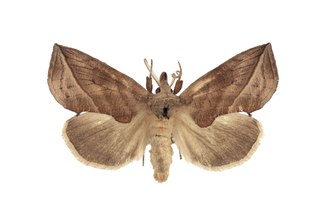
Calyptra canadensis, the Canadian owlet or meadow rue owlet moth, is a moth of the family Erebidae. The species was first described by Charles J. S. Bethune in 1865. It is found in North America from Nova Scotia to North Carolina in mountains, west to Texas, north to Saskatchewan, and occasionally Alberta. It is the only insect from the Calyptra genus to habitat North America. Adults of this species feeds on fruit.
Chrysanympha formosa, the Formosa looper, is a moth of the family Noctuidae. The species was first described by Augustus Radcliffe Grote in 1865. It is found in North America from Newfoundland west to Manitoba and south to the mountains of North Carolina and Tennessee.

Oligocentria semirufescens, the red-washed prominent moth or rusty prominent, is a moth of the family Notodontidae. The species was first described by Francis Walker in 1865. It is found in North America from Nova Scotia west to Vancouver Island, south to Florida, Colorado and central California.
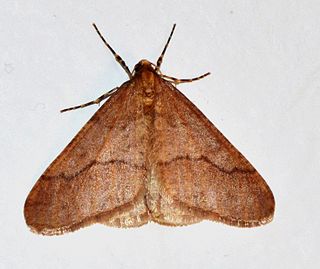
Erannis tiliaria, the linden looper, also known under the rather ambiguous name "winter moth", is a moth of the family Geometridae. The species was first described by Thaddeus William Harris in 1841. It is found in North America from central Alberta east to Nova Scotia, south to Missouri, Georgia, Utah and Texas.
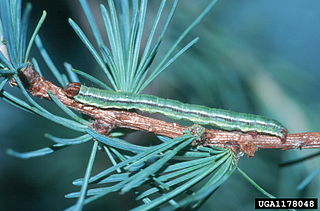
Macaria oweni, Owen's larch looper or Owen's angle moth, is a moth of the family Geometridae. The species was first described by Louis W. Swett in 1907. It is found in North America from Newfoundland to west-central Alberta, south in the east to northern New England.
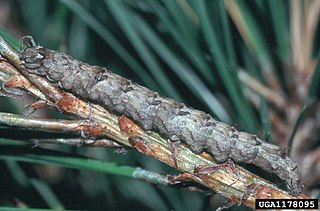
Zale metatoides, the washed-out zale or jack pine false looper, is a moth of the family Noctuidae. The species was first described by James Halliday McDunnough in 1943. It is found in barrens and pine woodlands from at least Wisconsin and probably Manitoba to Maine, south to the mountains of Georgia. The range in the Gulf States is not certain.
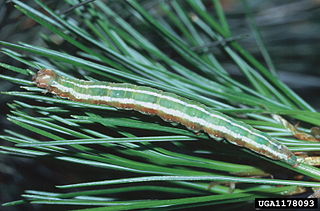
Zale helata, the brown-spotted zale, is a moth of the family Noctuidae. The species was first described by James Halliday McDunnough in 1943. It is found in barrens and pine woodlands from Manitoba to Maine, south to northern Alabama and Texas.
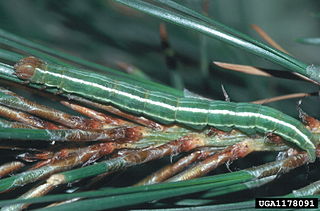
Zale curema, the black-eyed zale or northeastern pine zale, is a moth of the family Noctuidae. The species was first described by John Bernhard Smith in 1908. It is found from New York to Maine, south to western North Carolina, west to the Gulf States and Texas. The species is listed as endangered in Connecticut.
Zale buchholzi, or Buchholz's zale, is a moth of the family Erebidae. The species was first described by James Halliday McDunnough in 1943. It is found in coastal pinelands of the Atlantic coastal plain from New Jersey to Florida, west along the Gulf Coast to Texas.
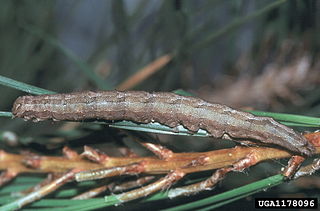
Zale obliqua, the oblique zale, is a moth of the family Noctuidae. The species was first described by Achille Guenée in 1852. It is found in barrens and pine woodlands of the United States from Ohio to southern Maine, south to northern Florida, Mississippi and Texas.

Melanolophia imitata, the western carpet or green-striped forest looper, is a moth of the family Geometridae. The species was first described by Francis Walker in 1860. It is found in western North America from southern California, north to Alaska and east to extreme south-western Alberta.

Zale lunifera, the bold-based zale or pine barrens zale, is a moth of the family Noctuidae. The species was first described by Jacob Hübner in 1818. It occurs primarily east and south of the Appalachian Mountains, from southern Maine south to Lee County, Mississippi, Mississippi and Florida. It is not known from south-eastern Virginia or South Carolina, but the species may occur in these regions. Lack of suitable habitat in Maryland and Delaware makes occurrence in these states unlikely. It also occurs inland to the mountains of Virginia and Lebanon County, Pennsylvania. In south-eastern Georgia it inhabits open, sandy pine-oak forest.

Zale minerea, the colorful zale, large false looper or mahogany similar-wing, is an owlet moths in the family Erebidae. The species was first described by Achille Guenée in 1852. It is found in North America.

















